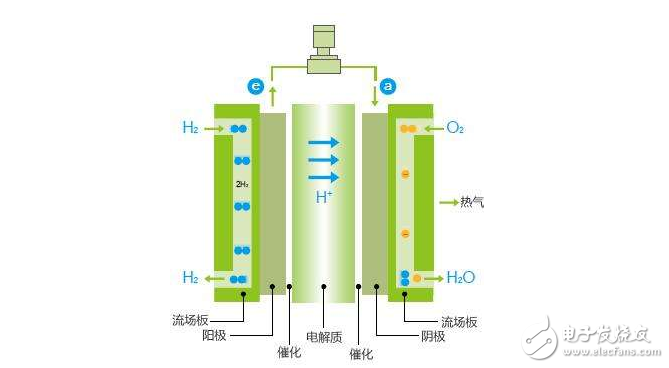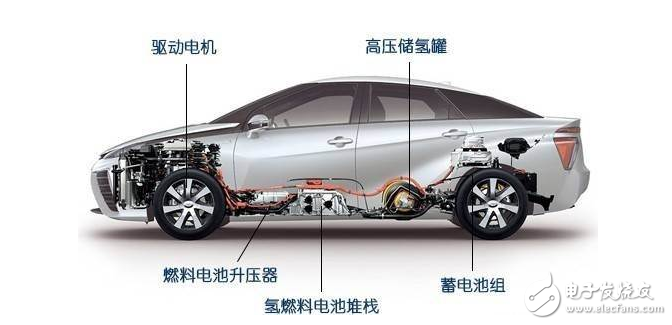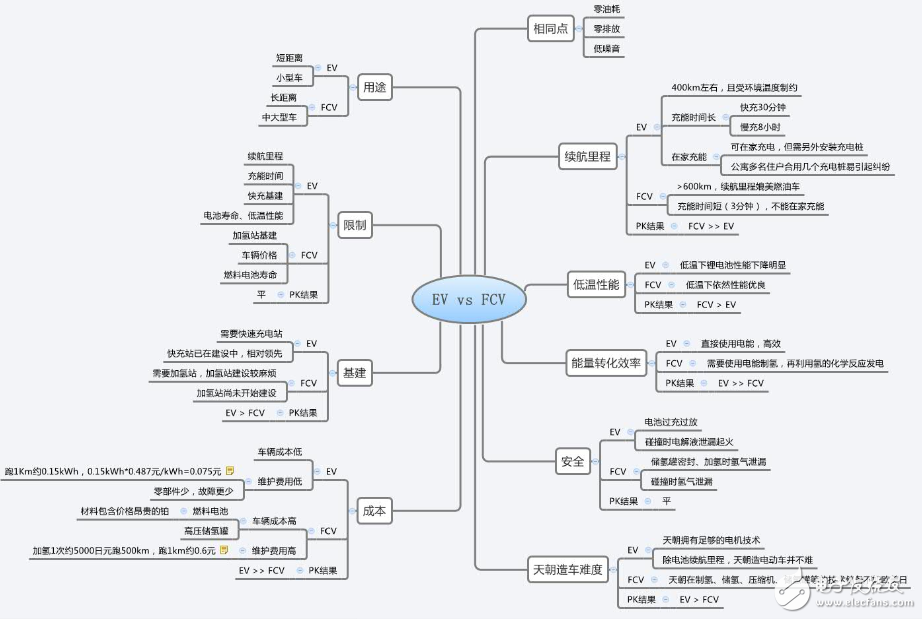A hydrogen fuel cell is a battery that uses hydrogen as a chemical element to store energy. The basic principle is the reverse reaction of electrolyzed water, which supplies hydrogen and oxygen to the anode and cathode respectively. After hydrogen diffuses outward through the anode and reacts with the electrolyte, the electrons are released to the cathode through an external load.
Like a normal battery, a fuel cell consists of an anode, a cathode, and an electrolyte. Most fuel cell vehicles use polymer exchange membrane fuel cells (PEMFC). The basic working principle of a hydrogen fuel cell is to send hydrogen gas to the anode plate (negative electrode) of the fuel cell. Through the action of the catalyst, platinum, one electron in the hydrogen atom is separated, and the hydrogen ions (protons) that lose electrons pass through the proton. The membrane is exchanged and reaches the cathode plate (positive electrode) of the fuel cell, recombined with oxygen atoms and hydrogen ions into water, as shown.
Since the oxygen supplied to the cathode plate is obtained from the air, the electric energy can be continuously supplied as long as hydrogen is continuously supplied to the anode plate, air is supplied to the cathode plate, and water (vapor) is taken away in time. Since hydrogen fuel cells do not store energy, they should be called hydrogen generators.

A dry battery and a battery are energy storage devices that store electrical energy and release it when needed. Hydrogen fuel cells are strictly a power generation device, like a power plant, that converts chemical energy directly into electrical energy. Chemical power generation unit. In addition, the electrode of the hydrogen fuel cell is made of a special porous material, which is a key technology of the hydrogen fuel cell. It not only provides a large contact surface for the gas and the electrolyte, but also catalyzes the chemical reaction of the battery. .
Toyota Motor Corporation has launched a hydrogen fuel cell vehicle and will be available in the first half of 2015. On January 6, 2014, Toyota, a well-known automobile manufacturer, announced that it will provide 5,680 fuel cell-related technical patents for other manufacturers, including technical patents for fuel cells, hydrogen storage tanks, and battery control systems. Toyota’s move It is to promote the promotion and popularization of electric vehicles with hydrogen as the main fuel. Hydrogen fuel cell technology is one of the ten new technologies that will change human life in the future and will become a new way to solve the oil crisis.

Fuel cell vehicle
In fact, hydrogen fuel cells are not a new technology. In the 1960s, hydrogen fuel cells have been successfully used in the aerospace industry. This small, large-capacity device was installed on the Apollo spacecraft between space and the Earth.
After entering the 1970s, as people continue to master a variety of advanced hydrogen production technologies, hydrogen fuel cells will soon be used in power generation and automobiles. On April 3, 2008, Boeing successfully tested a small aircraft powered by hydrogen fuel cells.
A lot of hot talks about hydrogen fuel cell vehicles and electric vehicles have been launched around the world, and domestic public opinion is also questioning the strategic orientation of China's pure electric drive as a new energy vehicle.
Hydrogen fuel cell vehicles are the ultimate environmentally friendly car. Hydrogen fuel cell vehicles have zero emissions, and a long hydrogenation mileage, short hydrogenation time, equivalent to gasoline vehicles, has been used as one of the new energy vehicle technology routes.

1. The source of hydrogen.
Unlike nitrogen and oxygen, hydrogen is the most important component of air. It is a less economical way to get hydrogen, but this is a very economical method. You want to start with electrolyzed water, consume electricity, generate hydrogen, and there will be energy loss in the process of hydrogen regenerative power. The electricity of electrolyzed water is now mainly emitted from coal-fired electricity. Coal-fired power generation also has energy loss. .
2. The scarcity of metallic platinum.Metal platinum is used as a catalyst in the process of hydrogen fuel cell power generation. This kind of metal is the platinum that buys a ring more expensive than 24K gold. It is less expensive, it is expensive, then the large-scale production of hydrogen fuel cells, this platinum is the bottleneck, there is no effect of cost reduction after scale, but the demand is more How expensive is it, how can this be done?
3. Hydrogen safety.
Some people say that carrying a hydrogen cylinder is like taking a hydrogen bomb. Will this hydrogen cylinder explode? Hydrogen is the lightest gas, and its diffusivity is extremely strong. The diffusion coefficient of hydrogen is 3.8 times larger than that of air and 7.5 times larger than that of gasoline. It can be proved that hydrogen is more reliable than gasoline. So a small amount of hydrogen leaks can be quickly diluted into a safe mixture in the air. Hydrogen has a small specific gravity and is easy to escape upwards, which makes the hydrogen impact range much smaller in the event of an accident.
4. The cost of manufacturing and using green hydrogen is higher.
The main problem with fuel cell vehicles is that the hydrogen fuels that drive them consume more energy than ordinary electric vehicles. Pollution is also a very serious problem. In addition to methane conversion, the only viable way to obtain green hydrogen is through electrolysis. But frankly, the electricity consumed in this process can be better used in ordinary electric vehicles.
The research and development of domestic hydrogen fuel cell vehicles has been around for 15 years. In the national "Energy Conservation and New Energy Vehicle Industry Development Plan (2012-2020)", it is clear that hydrogen fuel cell vehicles are developing in parallel with the international market. However, in recent years, the gap between the development level of domestic hydrogen fuel cell vehicles and advanced countries has increased, mainly reflected in: hydrogen fuel cells are generally in the stage of engineering development, power characteristics, cold start, reliability and other major technical performance indicators and the world. There is still a big gap between the benchmark products. There are not many patents in the key technology fields, the technical standards are not formed, the cost is high, and the products are basically not commercialized.
The main reason for the increase is that compared with electric vehicles, hydrogen fuel cell vehicles have high technical thresholds and require huge investment. Our technology and industrial base are weak, capital and technical strength are seriously insufficient, the technology chain is imperfect, and industrialization capacity is weak. In addition to SAIC, most vehicle manufacturers have not carried out substantial research and development and industrialization preparations for hydrogen fuel cell vehicles. Key materials such as catalysts and bipolar plates, and key components such as high-pressure hydrogen storage tanks, air compressors, and hydrogen circulation pumps are basically not industrialized, and the industrial chain has not yet formed.
Despite this, hydrogen fuel cell vehicles have also been mass-produced and are already on sale. The Toyota hydrogen fuel cell vehicle Mirai started at $57,500 (about RMB 357,000) overseas, but fell below $45,000 (about RMB 279,000) under the stimulus of the federal and state governments. In the United States, instalments can be paid in the form of $499 per month for 36 months. In addition, Toyota and Honda will provide buyers with three years of free hydrogen. Major auto companies are also planning to gradually increase the number of hydrogen fuel stations.
Hydrogen fuel cell vehicles may not be comparable to electric vehicles that save money and save money. But in the minds of consumers, practicality is also very important: fuel-battery cars are filled with fuel for a shorter period of time and travel farther. Moreover, hydrogen fuel cell vehicles are still in the early stages, and there are many seemingly insurmountable problems in rechargeable electric vehicles 10 years ago, and now there are many electric vehicles in various countries. Therefore, we are full of confidence in the future of hydrogen fuel vehicles.
Background Frame,Photography Backdrop,Photo Studio Background,Photography Studio Backdrop
SHAOXING SHANGYU FEIXIANG PHOTOGRAPHIC CO.,LTD , https://www.flying-photography.com